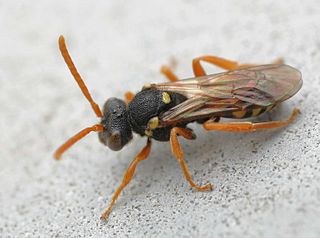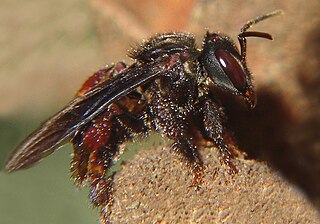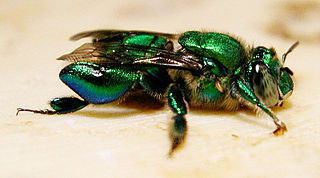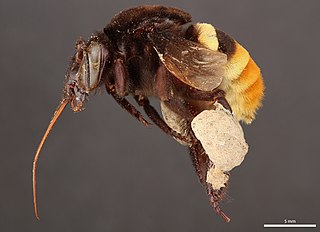
A bumblebee is any of over 250 species in the genus Bombus, part of Apidae, one of the bee families. This genus is the only extant group in the tribe Bombini, though a few extinct related genera are known from fossils. They are found primarily in higher altitudes or latitudes in the Northern Hemisphere, although they are also found in South America, where a few lowland tropical species have been identified. European bumblebees have also been introduced to New Zealand and Tasmania. Female bumblebees can sting repeatedly, but generally ignore humans and other animals.

Apidae is the largest family within the superfamily Apoidea, containing at least 5700 species of bees. The family includes some of the most commonly seen bees, including bumblebees and honey bees, but also includes stingless bees, carpenter bees, orchid bees, cuckoo bees, and a number of other less widely known groups. Many are valuable pollinators in natural habitats and for agricultural crops.

The subfamily Xylocopinae occurs worldwide, and includes the large carpenter bees, the small carpenter bees, the allodapine bees, and the relictual genus Manuelia.

Bombus terrestris, the buff-tailed bumblebee or large earth bumblebee, is one of the most numerous bumblebee species in Europe. It is one of the main species used in greenhouse pollination, and so can be found in many countries and areas where it is not native, such as Tasmania. Moreover, it is a eusocial insect with an overlap of generations, a division of labour, and cooperative brood care. The queen is monogamous which means she mates with only one male. B. terrestris workers learn flower colours and forage efficiently.

Nomadinae is a subfamily of bees in the family Apidae. They are known commonly as cuckoo bees.

The Leucospidae are a specialized group of wasps within the superfamily Chalcidoidea, that are ectoparasitoids of aculeate wasps or bees. They are typically mimics of bees or stinging wasps, often black with yellow, red, or white markings, sometimes metallic, with a robust mesosoma and very strong sculpturing. The hind femora are often greatly enlarged, with a row of teeth or serrations along the lower margin as in Chalcididae. The wing has a longitudinal fold. The female ovipositor is sometimes short, but if not, it is recurved and lies along the dorsal side of the metasoma, a unique feature. The males are also unusual, in the fusion of many of the metasomal segments to form a capsule-like "carapace".

The Andrenidae are a large, nearly cosmopolitan family of solitary, ground-nesting bees. Most of the family's diversity is located in temperate or arid areas. It includes some enormous genera. One of the subfamilies, Oxaeinae, is so different in appearance that they were typically accorded family status, but careful phylogenetic analysis reveals them to be an offshoot within the Andrenidae, very close to the Andreninae.

Trigona is one of the largest genera of stingless bees, comprising about 32 species, exclusively occurring in the New World, and formerly including many more subgenera than the present assemblage; many of these former subgenera have been elevated to generic status.

Euglossa is a genus of orchid bees (Euglossini). Like all their close relatives, they are native to the Neotropics; an introduced population exists in Florida. They are typically bright metallic blue, green, coppery, or golden.

Eulaema is a genus of large-bodied euglossine bees that occur primarily in the Neotropics. They are robust brown or black bees, hairy or velvety, and often striped with yellow or orange, typically resembling bumblebees. They lack metallic coloration as occurs in the related genus Eufriesea.

Tetragonula carbonaria is a stingless bee, endemic to the north-east coast of Australia. Its common name is sugarbag bee. They are also occasionally referred to as bush bees. The bee is known to pollinate orchid species, such as Dendrobium lichenastrum, D. toressae, and D. speciosum. It has been identified as an insect that collects pollen from the cycad Cycas media. They are also known for their small body size, reduced wing venation, and highly developed social structure comparable to honey bees.
Heinrich Friedrich August Karl Ludwig Friese was a German biologist and entomologist, a specialist of bees (melittologist). Between 1883 and 1939, he described 1,989 new species and 564 new varieties or subspecies of insects, 99% of which were bees.

The Rhathymini are a tribe of kleptoparasitic apid bees.

Sphecodopsis is a genus of cleptoparasitic cuckoo bees in the family Apidae. Endemic to southern Africa, the wasp-like bees of this genus are generally small, varying from 3.9 to 9 mm in length, and mostly black, with orange-ish or reddish colouring of the metasoma in some of the species. The bee genus Scrapter is recognised as a host for the cleptoparasitic life cycle of some Sphecodopsis, but further data regarding preferred hosts is not available for most of the species.

Exomalopsis is a genus of bees in the family Apidae. They occur in the Western Hemisphere.
Apicystis bombi is a species of parasitic alveolates in the phylum Apicomplexa. It infects bees, especially bumblebees. It is believed to have a cosmopolitan distribution in bumblebees and a sporadic occurrence in honey bees, and causes disease symptoms in nonresistant bee species.
Euglossa jacquelynae is a Euglossine bee species found in Central Brazil.

Meloetyphlus fuscatus, the blind blister beetle, is a species of blister beetle in the family Meloidae found in Central and South America. They are kleptoparasites of orchid bees and are entirely blind as adults. Unique among meloids, females do not lay their eggs near flowers, but rather within their hosts' nests.
Apis mellifera artemisia is the Russian steppe honey bee, first identified in 1999 near Kyiv, Ukraine, by only one specimen, but by 2011 its taxonomic status had been called into question, although to date no DNA analysis has been conducted: At the same time the taxonomic status of the Apis mellifera ruttneri on Malta was also called into question, however in 2017 it was confirmed that Apis mellifera ruttneri was a new and separate subspecies.
Apis mellifera sossimai extending from the west of Ukraine centrally and southwards towards the Caucasus mountains. However in 2011 research from Russia conducted mtDNA analysis showing that the A. m. sossimai was not a separate subspecies, but only an ecotype of the Apis mellifera macedonica subspecies.















